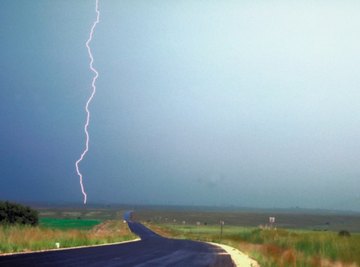
Energy, in the physical sciences, is the ability for a system to do work. Work is the force a system produces on another system over a distance. Therefore, energy is equal to the ability of a system to pull or push against other forces. Mechanical energy is the sum of kinetic energy and potential energy in a system.
Kinetic Energy
When an object is in motion, the type of energy we are seeing expressed is kinetic energy. Some of the many forms of kinetic energy include rotational (energy from spinning around an axis), vibrational (energy from vibration), and translational (energy from the movement from one location to another). The equation to solve for the amount of kinetic energy of an object at a given time is:
where m is the mass of the object and v is the velocity of the object.
Potential Energy
Where kinetic energy is the energy of motion, potential energy is the energy stored in an object depending on its position. In this form, the energy is not doing work, but it does have the potential to be converted to other energy forms. In the case of mechanical energy, potential energy transforms into kinetic energy when the object is set into motion. Two forms of potential energy are gravitational and elastic potential energy. Gravitational potential energy is the energy of an object depending on its height above the ground. Elastic potential energy is the energy stored in an object that is stretched or compressed, like a spring.
The formula to calculate potential energy depends on the type of force involved. For gravity, we express potential energy as:
where m is mass, g is the acceleration due to gravity (~9.8 meters per second per second), and h is the height above the ground.
The Law of Conservation of Energy
The law of conservation of energy is a fundamental law of physics; it states that in an isolated system, the total energy within the system is conserved. That is to say, though the amount of kinetic energy and potential energy can change from moment to moment, the total amount of energy in a closed system is constant.
An object's mechanical energy, never changes as long as it remains isolated; this is the conservation of mechanical energy.
Total Amount of Mechanical Energy
The mechanical energy of a system is the sum of the kinetic and potential energy within the system:
The result of this equation is called the total mechanical energy. Mechanical energy is measured in units called joules. Objects with mechanical energy are either in motion or have stored energy to do work. While an isolated system conserved its mechanical energy, this doesn't typically happen in the real word because some of the potential energy of an object is transformed into other forms of energy, such as heat, through air resistance and friction. This energy becomes lost through non-conservative forces.
Examples of Mechanical Energy Use
Whenever there are moving objects, there is mechanical energy at play; it is involved in nearly every instance of power generation and usage.
When we have energy sources that store chemical energy or electrical energy (like some fuels or batteries), we can use engines and motors to convert this energy into mechanical output. Different forms of energy will be translated using different mechanisms, but everything from box fans to race cars use principles of mechanical energy conversion to enact work.
Tips
Steam engines use the heat energy from burning coal to evaporate water; they then create mechanical energy through pressure.
If we want to move energy from a mechanical energy source to electrical energy, we use generators or power plants. The most common types of generators and power plants use the work from mechanical energy to move turbines that create electrical energy through electromagnetic interactions. Hydroelectric power, nuclear energy, geothermal plants, and traditional coal burning power plants all use this method to convert heat energy into mechanical energy into electrical energy (or in the case of hydropower or wind turbines, it starts as mechanical energy).
References
About the Author
Luc Braybury began writing professionally in 2010. He specializes in science and technology writing and has published on various websites. He received his Bachelor of Science in applied physics from Armstrong Atlantic State University in Savannah, Ga.
Photo Credits
Photos.com/AbleStock.com/Getty Images
